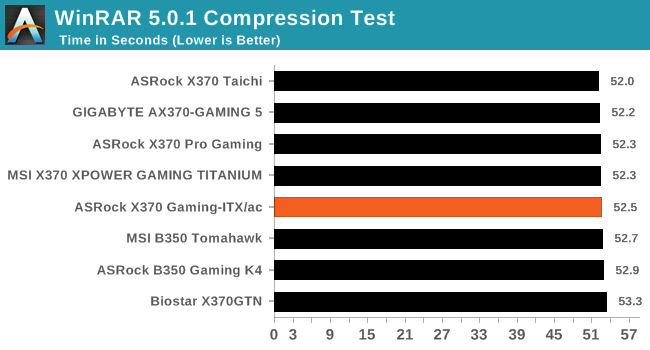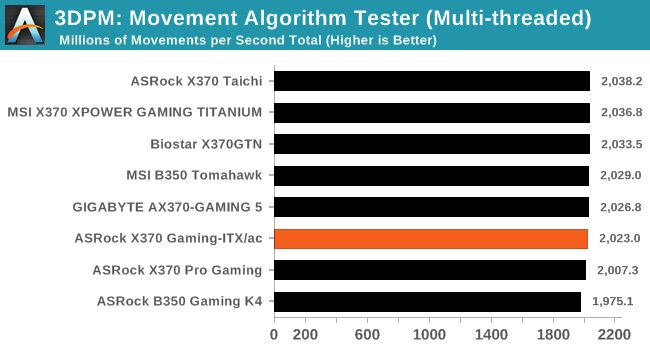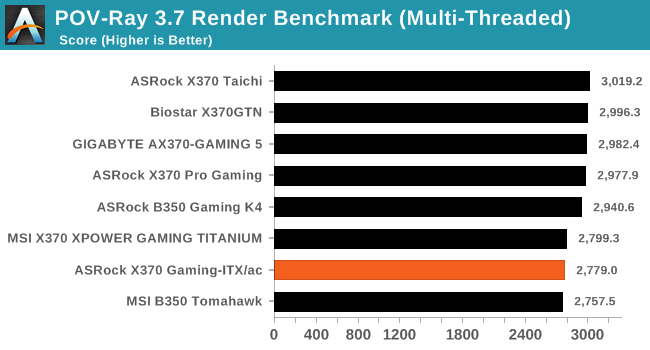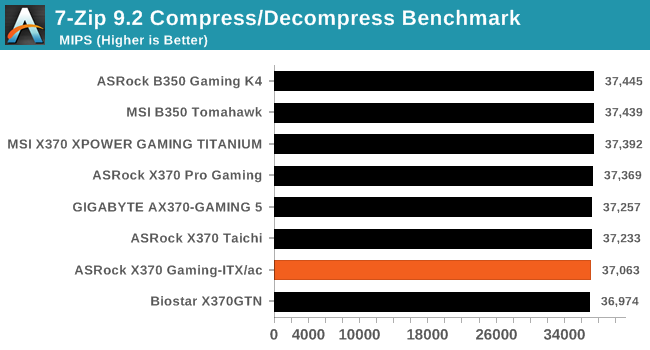The ASRock X370 Gaming-ITX/ac Motherboard Review
by Gavin Bonshor on April 18, 2018 8:00 AM EST- Posted in
- Motherboards
- Gaming
- AMD
- ASRock
- Mini ITX
- ITX
- AM4
- Ryzen
- X370
- X370 Gaming-ITX/ac
CPU Performance, Short Form
For our motherboard reviews, we use our short form testing method. These tests usually focus on if a motherboard is using MultiCore Turbo (the feature used to have maximum turbo on at all times, giving a frequency advantage), or if there are slight gains to be had from tweaking the firmware. We put the memory settings at the CPU manufacturers suggested frequency, making it very easy to see which motherboards have MCT enabled by default.
Video Conversion – Handbrake v1.0.2: link
Handbrake is a media conversion tool that was initially designed to help DVD ISOs and Video CDs into more common video formats. For HandBrake, we take two videos and convert them to x264 format in an MP4 container: a 2h20 640x266 DVD rip and a 10min double UHD 3840x4320 animation short. We also take the third video and transcode it to HEVC. Results are given in terms of the frames per second processed, and HandBrake uses as many threads as possible.



Compression – WinRAR 5.4: link
Our WinRAR test from 2013 is updated to the latest version of WinRAR at the start of 2017. We compress a set of 2867 files across 320 folders totaling 1.52 GB in size – 95% of these files are small typical website files, and the rest (90% of the size) are small 30 second 720p videos.

Point Calculations – 3D Movement Algorithm Test v2.1: link
3DPM is a self-penned benchmark, taking basic 3D movement algorithms used in Brownian Motion simulations and testing them for speed. High floating point performance, MHz and IPC wins in the single thread version, whereas the multithread version has to handle the threads and loves more cores. For a brief explanation of the platform agnostic coding behind this benchmark, see my forum post here. We are using the latest version of 3DPM, which has a significant number of tweaks over the original version to avoid issues with cache management and speeding up some of the algorithms.

Rendering – POV-Ray 3.7.1b4: link
The Persistence of Vision Ray Tracer, or POV-Ray, is a freeware package for as the name suggests, ray tracing. It is a pure renderer, rather than modeling software, but the latest beta version contains a handy benchmark for stressing all processing threads on a platform. We have been using this test in motherboard reviews to test memory stability at various CPU speeds to good effect – if it passes the test, the IMC in the CPU is stable for a given CPU speed. As a CPU test, it runs for approximately 2-3 minutes on high end platforms.

Synthetic – 7-Zip 9.2: link
As an open source compression tool, 7-Zip is a popular tool for making sets of files easier to handle and transfer. The software offers up its own benchmark, to which we report the result.











30 Comments
View All Comments
Daedalus685 - Wednesday, April 18, 2018 - link
I'm fairly certain you are correct. The board appears to have usb 3.1 (gen 1) ports only (formerly called USB 3.0), i.e. 5Gbps.The type C, and A ports are a different colour of blue, but all of the documentation refers to them as gen 1 ports.
gavbon - Wednesday, April 18, 2018 - link
Yeah, the board does lack USB 3.1 Gen2, it does make the B350 Gaming ITX-ac (B350 version of this board) seem like a great investment for a Mini-ITX system since you lose all the multi-GPU support benefits from X370 going small form factor.John_M - Saturday, April 28, 2018 - link
The renaming of USB 3.0 to USB 3.1 Gen 1 is a confusing mess and it only gets worse with USB 3.2. Just to emphasise, this board does _not_ have 10 Gb/s USB 3.1 Gen 2. Even the colour of the ports is misleading. Colour and the presence of a Type C socket is no guarantee of 10 Gb/s operation. It is limited to 5 Gb/s USB 3.1 Gen 1 (formerly known as USB 3.0).microking4u - Wednesday, April 18, 2018 - link
Having built a B350 myself, would love for you guys to test using an M.2 NVME SSD as your OS boot drive and running 2 SATA SSD drives in RAID 0 for DATA storage (No need to reply about reliability please) and see how smooth that goes and dry to update RAID drivers?I have had no issues with Intel 8th Gen ITX boards with this setup, but its a complete headache and reliability/perfomance issue with AMD!
The_Assimilator - Wednesday, April 18, 2018 - link
Wait, so the Biostar X370GTN gets called out for having a tiny heatsink, yet this board doesn't?Plus that board costs $50 less and has better I/O (4 rear USB 3.0 vs only 2 on this "high-end" offering). The only real sin the Biostar commits is using Realtek for networking, but at 50 less bucks, that's probably excusable.
Not to say the Biostar isn't without faults - going with Realtek networking is vomit-inducing - but
The_Assimilator - Wednesday, April 18, 2018 - link
One day, AnandTech will allow users to edit their comments. That day, is not this day.gavbon - Wednesday, April 18, 2018 - link
The heatsink might be small, but it's definitely more adequate than the one on the Biostar X370GTN. I actually sat at my desk today while doing some write-ups thinking to myself which has the worst VRM heatsink of the ITX boards on my desk...The Gigabyte AB350-Gaming Wi-Fi, X370GTN and the ASRock X370 Gaming-ITX/ac - I haven't yet concluded, although I do intend to find out for my own benefit as I want to build a small Ryzen 2200G system and quality is everything to me!!1_rick - Wednesday, April 18, 2018 - link
I have this board. It does have 4 USB 3.0 ports on the back (3 type A and 1 type C).1_rick - Wednesday, April 18, 2018 - link
I've got a 1600X running 3.95GHz @ (IIRC) 1.375V stably. I haven't gotten it to run at anything higher, but I haven't done much testing, either. It crashed almost immediately running Prime95 at that voltage and the next up (1.38 something) and by that time I was getting tired of the testing.For some reason, the ethernet port on the back of mine quit working, which is obviously annoying, although the wifi works. (I upgraded the antenna because the one that's included is a little bit fragile, I pulled on it too hard once, and disconnected the wire from the socket, so that's probably more my fault than ASRock's.)
gavbon - Wednesday, April 18, 2018 - link
You could have damaged the wiring, can you see any physical damage at all?